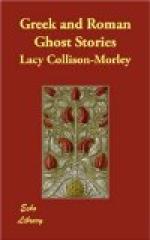When we come to inquire into the appearance of ghosts revisiting the glimpses of the moon, we find, as we should expect, that they are a vague, unsubstantial copy of their former selves on earth. In Homer[12] the shade of Patroclus, which visited Achilles in a vision as he slept by the sea-shore, looks exactly as Patroclus had looked on earth, even down to the clothes. Hadrian’s famous “animula vagula blandula” gives the same idea, and it would be difficult to imagine a disembodied spirit which retains its personality and returns to earth again except as a kind of immaterial likeness of its earthly self. We often hear of the extreme pallor of ghosts, which was doubtless due to their being bloodless and to the pallor of death itself. Propertius conceived of them as skeletons;[13] but the unsubstantial, shadowy aspect is by far the commonest, and best harmonizes with the life they were supposed to lead.
Hitherto we have been dealing with the spirits of the dead who have been duly buried and are at rest, making their appearance among men only at stated intervals, regulated by the religion of the State. The lot of the dead who have not been vouchsafed the trifling boon of a handful of earth cast upon their bones was very different. They had not yet been admitted to the world below, and were forced to wander for a hundred years before they might enter Charon’s boat. AEneas beheld them on the banks of the Styx, stretching out their hands “ripae ulterioris amore.” The shade of Patroclus describes its hapless state to Achilles, as does that of Elpenor to Odysseus, when they meet in the lower world. It is not surprising that the ancients attached the highest importance to the duty of burying the dead, and that Pausanias blames Lysander for not burying the bodies of Philocles and the four thousand slain at AEgospotami, seeing that the Athenians even buried the Persian dead after Marathon.[14]
The spirits of the unburied were usually held to be bound, more or less, to the spot where their bodies lay, and to be able to enter into communication with the living with comparative ease, even if they did not actually haunt them. They were, in fact, evil spirits which had to be propitiated and honoured in special rites. Their appearances among the living were not regulated by religion. They wandered at will over the earth, belonging neither to this world nor to the next, restless and malignant, unable to escape from the trammels of mortal life, in the joys of which they had no part. Thus, in the Phaedo[15] we read of souls “prowling about tombs and sepulchres, near which, as they tell us, are seen certain ghostly apparitions of souls which have not departed pure ... These must be the souls, not of the good, but of the evil, which are compelled to wander about such places in payment of the penalty of their former evil way of life.”
Apuleius[16] classifies the spirits of the departed for us. The Manes are the good people, not to be feared so long as their rites are duly performed, as we have already seen; Lemures are disembodied spirits; while Larvae are the ghosts that haunt houses. Apuleius, however, is wholly uncritical, and the distinction between Larvae and Lemures is certainly not borne out by facts.




